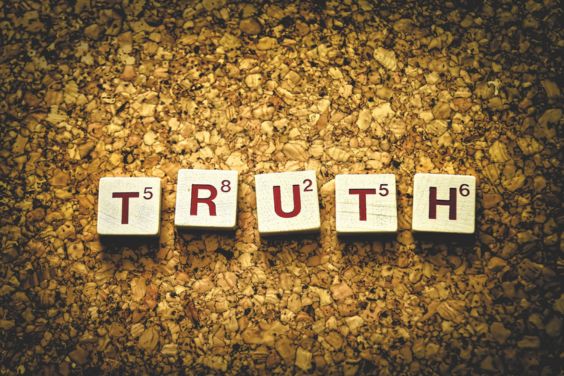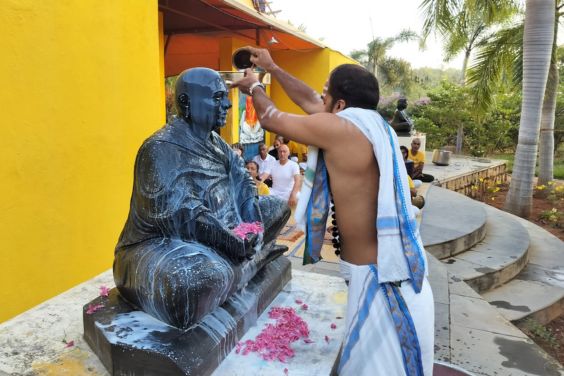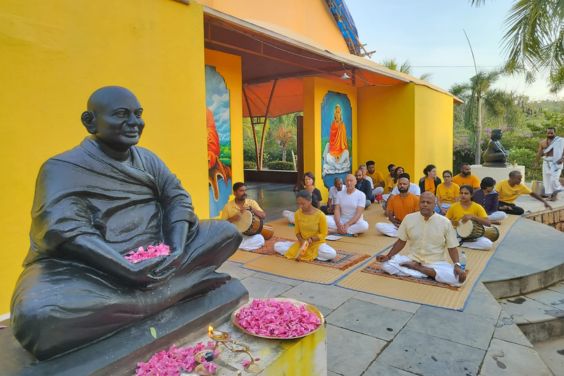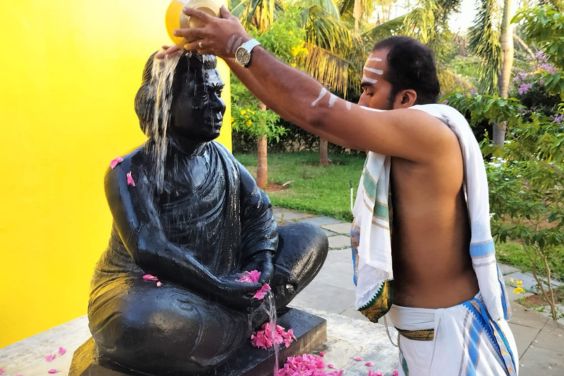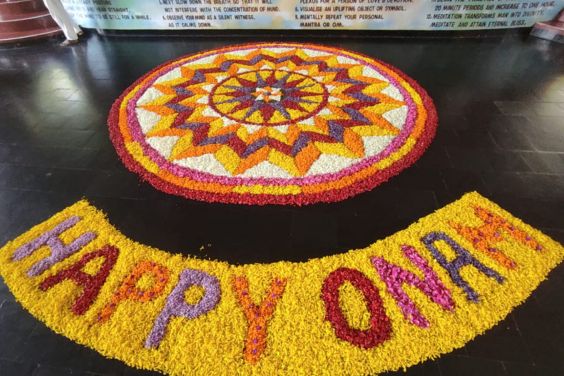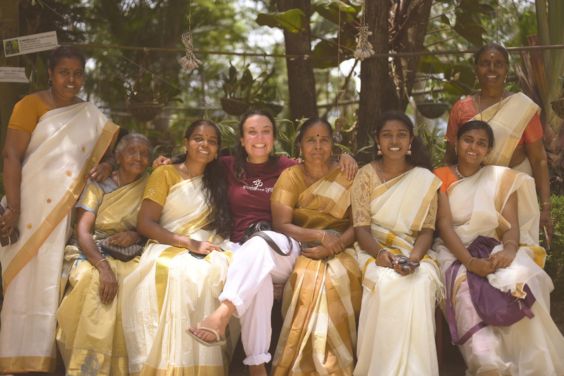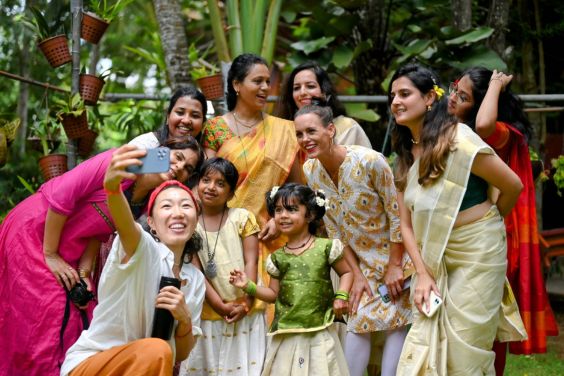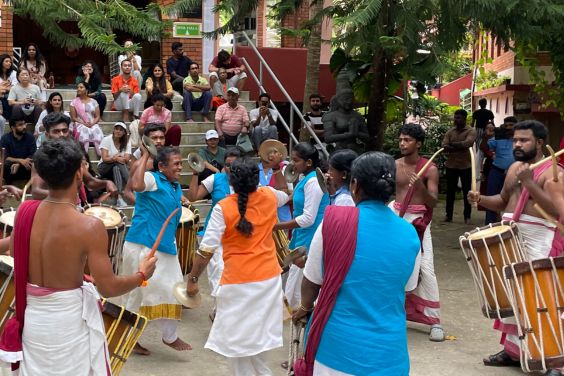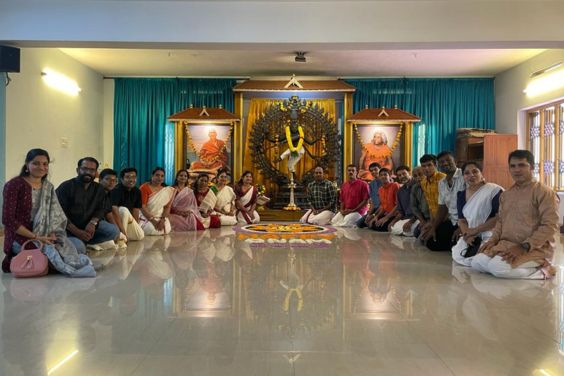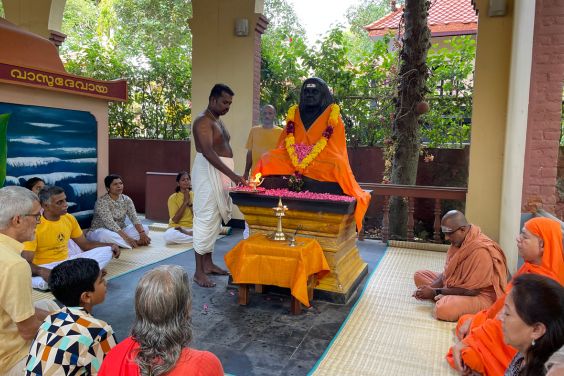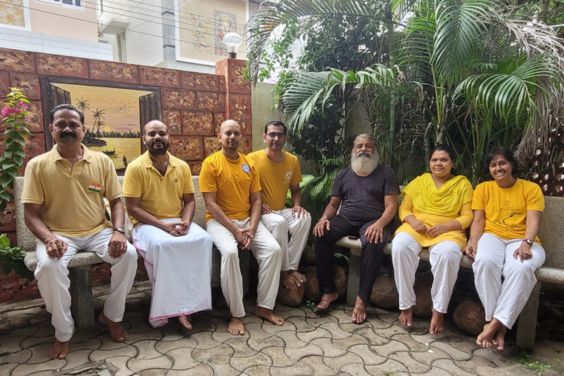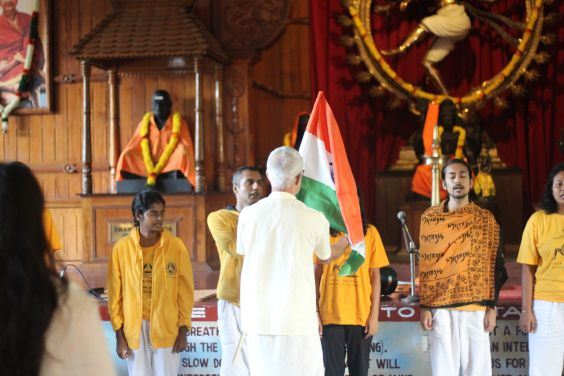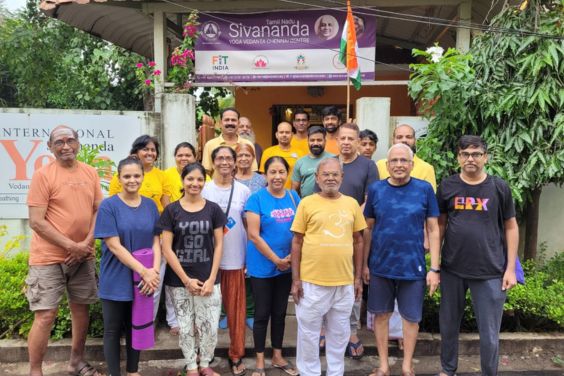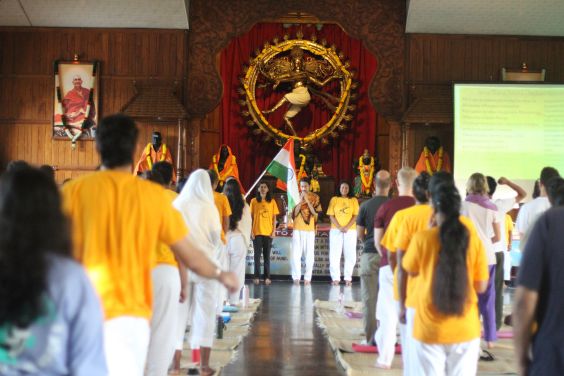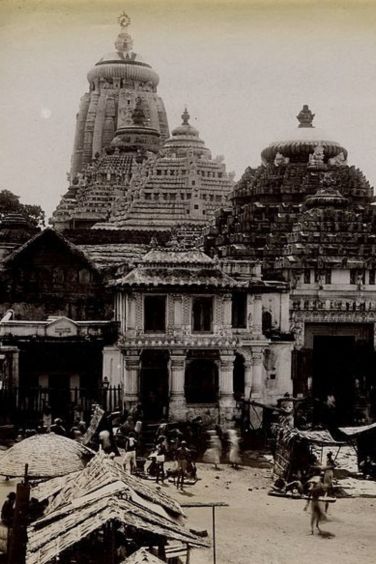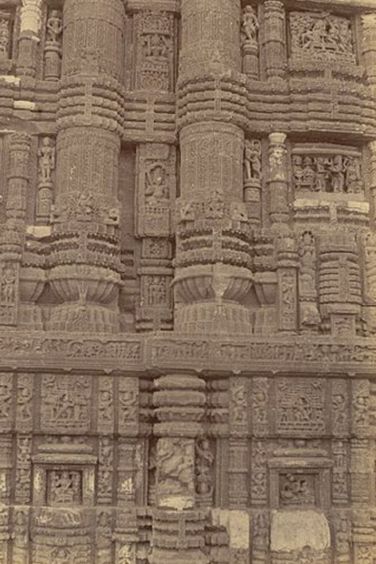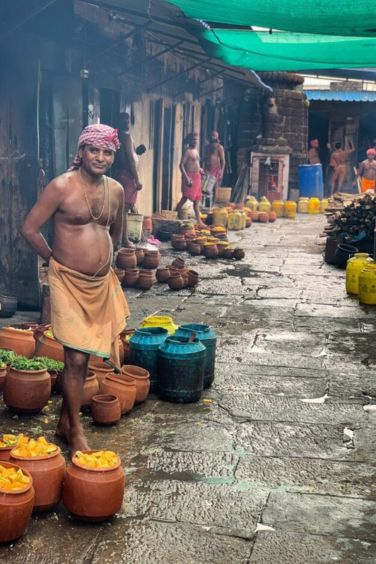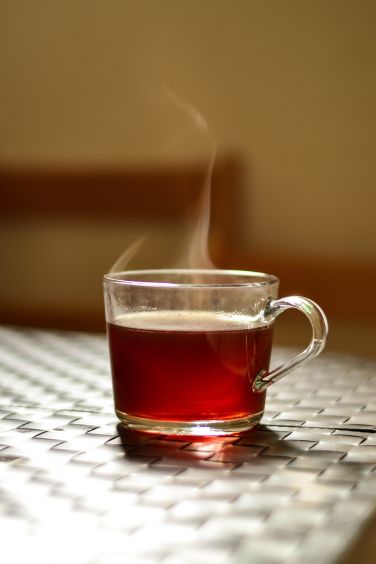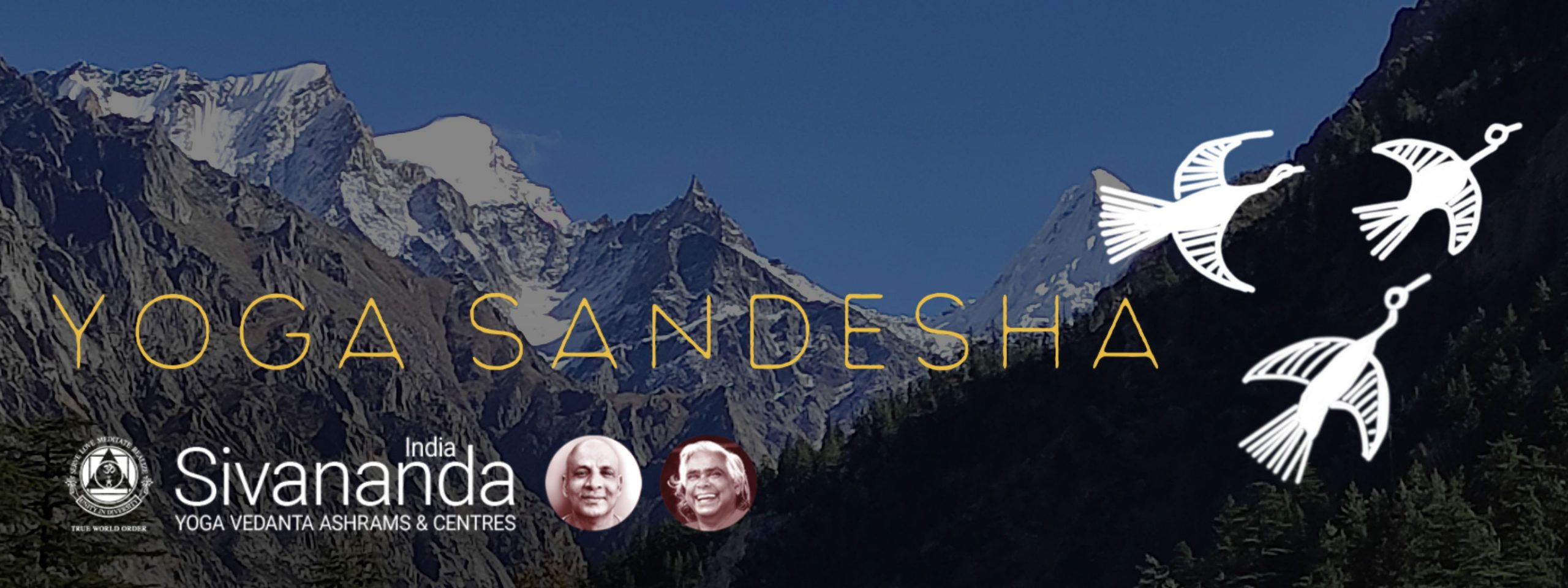
September 2023 | Satya
Om Namah Sivaya
Blessed Self,
The core strength of the organisation that Swami Vishnudevanandaji created is discipline–not an easy task for our rebellious minds and the mundane life we live in. When seekers visit the ashrams and centres that Swamiji created as spiritual homes, people fall in love with the discipline and when they go back home they often miss that the most.
The following excerpt about Master Swami Sivananda’s life is quite inspiring, “The Master practiced intense spiritual discipline for years altogether. He, who in later life impressed upon his devotees that spiritual discipline was not military discipline, but essentially self-discipline, had trained himself in a most systematic manner.” That same discipline was evident all through Swamiji’s life and teachings, and he passed that on to his disciples and students.
Realised saints often crave seclusion, even as they strive to impart what they have learned to students and show them how to be healthy, happy, and peaceful. Swamiji always wanted to stop what he was doing and go to the Himalayas to stay in seclusion, meditating and contemplating. His disciples and students, however, were so attached to him that they never let him.
When we consider why Swamiji created so many ashrams and spiritual homes, what happened in Master Sivananda’s own life gives us an idea. Even after God Realization, the Master did not want to build an ashram of his own. To spiritual aspirants who sought his guidance at that time he said, “I am only a common Sadhu. I may not be able to help you much. Further, I do not make disciples. I can be your sincere friend till the end of my life. I do not like to keep aspirants by my side for a long time. I give lessons for a couple of months and then ask my students to meditate in some solitary place in Kashmir or Uttarakhand.”
So let’s take inspiration from the above and see how Master and Swamiji impacted many lives, rather than simply judging them, and try to analyse from a practical perspective.
To conclude on a practical note, Madurai ashram’s compound wall was completed nicely and ashram landscaping is taking shape, making it feel like a real ashram with a proper structure. The Sivananda Free Rural Medical Hospital was inaugurated on August 24, with various dignitaies present to join us for the much-awaited opening. The hospital will serve local villagers without access to medical and specialist attention.
May Master and Swamiji’s blessings be with you all.
Pranams,
Sivananda Yoga Vedanta Ashrams & Centres, India
It is said that the truth doesn’t drown in water and it doesn’t burn in fire. That is to say that truth, or satya, is not destroyed, nor does it change. It is, and always remains true. We tend to think of truth in smaller ways, perhaps degrees of honesty, shades of truth, how often we tell the truth. We consider whether others are being truthful with us, perhaps more frequently than whether we ourselves are being fully truthful. There is a deep part inside us that knows truth and immediately recognises it in situations. That deep part is our own self.
As part of our focus on the Yamas and Niyamas, from Patanjali’s Raja Yoga system, this month we explore satya in our newsletter theme. We share Swami Sivananda’s words on the importance of truth in self-realisation, some of the many legends surrounding the Jagannath Temple in Odisha, how to keep truthful about your yoga practice, a tea recipe for good digestion, and a video about the inauguration of the new Sivananda Free Rural Medical Hospital within the Madurai Ashram.
We hope you enjoy the newsletter and find some things to reflect upon. As usual, please feel free to reach out to us with your thoughts and feedback: [email protected]
Serve All Projects:
Inauguration of Sivananda Free Rural Medical Clinic, Madurai
Inauguration of the Sivananda Free Rural Medical Hospital on August 24, 2023. The Hospital is within the Sivananda Yoga Vedanta Meenakshi Ashram, Saramthangi Village.
Local medical facilities in the villages are in very basic form. A day travelling to the city was often not feasible as the local people rely heavily on daily wages and couldn’t afford to spare a day to travel to the large city to avail proper treatment facilities.
The idea of providing free medical facilities for locals surrounding the Meenakshi Ashram was a dream. To have a local medical clinic would be a great blessing. The dream was conceived by a chance meeting with Mr. Vishnu Wallani from Toronto who expressed his interest to be part of the endeavour by donating for the initiation of Sivananda Free Rural Medical Clinic, with an ambulance service to transport villagers to and from the clinic.
We began the clinic in 2015 in association with Vikram Multispeciality Hospitals in Madurai, that was well received by everyone. On observing the medical needs of people at close quarters we also realized the need to provide them more services to raise their health and sanitisation standards. Though the agreed funding stopped after two years, Madurai Ashram and other locations in the Sivananda Organization continued to provide financial assistance to continue the medical camps, under the guidance of Acharya Prahlada ji.
In 2020, Prahlada ji presented the idea of building a free hospital within the Meenakshi Ashram premises to one of his students from Toronto, Mr Mazur. In 2021, Mr Mazur donated funds for the construction, plus 2 years support for the functioning of the hospital. What started off as a clinic with regular camps has today grown into a permanent hospital building where around 40 neighbouring villages can easily receive cure for their ailments, completely free of cost. The goal was to provide free medical services for around 2000 villagers on a weekly basis.
By the grace of Master Swami Sivanandaji and our Guru Swami Vishnudevanandaji we wish to you inform you that the project is completed. On August 24, 2023 the hard work of so many people directly and indirectly involved in building and setting up the Sivananda Free Rural Medical Hospital right next to our Meenakshi Ashram has paid off fruitfully. Helmed by Prahlada ji, our Indian Trustees also arrived to witness the inauguration by the honourable district collector of Madurai, Smt. Sangeeta ji. We also had a group of Sadhana Mandalam students along with Swami Janardhanananda ji joining us to grace the occasion.
The Collector, in her inspirational speech, spoke about how yoga teaches holistic well-being and that the free services of our hospital would be a welcome augmentation to good health. Everyone lauded the efforts to carry forward the teachings of our Swamiji whose main mission was to bring about happiness through health and wellness.
The entire event was covered by various Madurai newspapers as this endeavour is one of its kind in Saramthangi Village.
Close to 400 people attended the function and food was served to all by the Ashram, with the help of one of our students doing the catering. We would like to extend our special thanks to Dr. Narayanaswami and his staff for supporting this noble venture since its inception. Much appreciation goes to the generous Mazur family who are the reason this humanitarian cause came to life. Special thanks to our Acharya Prahlada ji for his diligence and motivation on this project.
With the teachings of our Master Swami Sivananda ji and Guru Swami Vishnudevananda ji, yoga trains us to be compassionate and helpful. We all pray to our Master and Swamiji to guide us in our attempt to serve humanity, by alleviating the physical miseries of life.
News Item: Installation of Gurus’ Statues at Madurai Ashram
After a long wait for the statues to be completed in Mahabalipuram, we were able to install new guru statues at the entrance to the Vishnu Hall at Madurai Ashram. Funds for the gurus’ statues were donated by a senior Swami in the organisation. We are grateful for the donation and that they are now finally on display, and that we can see them as we enter the hall each day for satsang or for class.
News Item: Onam Celebrations in Kerala
Onam is an annual rice harvest and cultural festival celebrated in Kerala by those of all faiths and communities. This year it was celebrated on August 29. Here are a few photos of celebrations in our Neyyar Dam Ashram and our centre in Trivandrum, and a few photos of Swami Sivasaradananda’s birth anniversary puja. Happy Onam!
News Item: Indian Independence Day Celebrations, August 15, 2023
Some photos of Independence Day celebrated at our Ashrams and Centres in India.
Research/Links
A perspective on yoga’s tools for personal excellence and well-being. The Patanjali Yoga Sutra’s panca koshas, yamas, and niyamas are discussed here, however from a more psychological and research-oriented perspective. Read more here: https://www.ncbi.nlm.nih.gov/pmc/articles/PMC10220233/
Spiritual Calendar
September 6 – Sri Krishna Jayanti
September 8 – Swami Sivananda’s Birthday
September 10 – Ekadasi
September 14 – New Moon
September 25 – Ekadasi
September 29 – Full Moon
Upcoming Courses:
Learn, Practise & Grow with Us!
Teachers’ Training Course (TTC)
September 10 to October 7, Netala, Himalayas
October 15 to November 11, Madurai, Tamil Nadu
November 12 to December 9, Neyyar Dam, Kerala
For more details, click here
Sadhana Intensive Course (SI)
October 15 to 28, Netala, Himalayas
For more details, click here
Courses in Thailand this fall at the Phu Chaisai Mountain Resort in Chiang Rai
Sadhana Intensive, September 16 to 30, 2023
Teachers’ Training Course, October 1 to 28, 2023
Advanced Teachers’ Training Course, October 1 to 28, 2023
Yoga Vacation, October 7 to 11 and October 21 to 25, 2023
For more details, click here
Sivananda Integrated Yoga Vedanta Ayurveda Meditation Music (SIYVAM)
October 24, 2023 to March 22, 2025 (18 months)
For more details, click here
Teachings Excerpt:
Truth, The First and the Last Thing by Swami Sivananda
Should you ask me “What is the first thing in Realization?”, I should reply “The first, second, and third thing therein, nay, all-is truthfulness”.
Let truth and purity light up your career, guide your conduct, and mould your character. If the mind is impure, Self-realization cannot be attained even if you meditate for twenty hours daily. Even Yudhishthira had to see the hell as he once told a lie-a modified, twisted truth, in a dexterous manner.
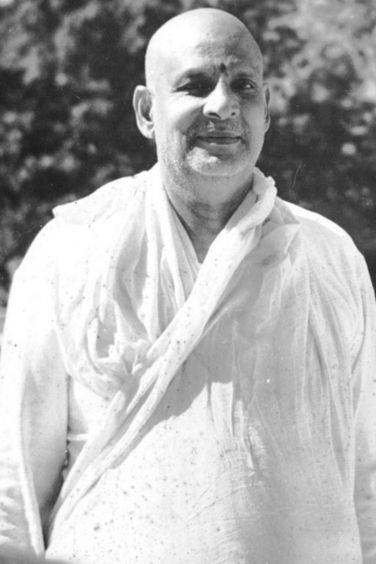
In truth, there is no deceit. That which is simulated is untruth.
Truth can never contradict non-injury. When it does, it is no more a truth, but the selfishness of the man which is on the fore.
When truth-speaking leads another to dishonour, injury and pain, it is no longer a virtue. Then it becomes a deadly sin.
Speak what is true. Speak what is pleasant. Speak no disagreeable truth, speak no agreeable falsehood.
Truth always exists in a pure unmixed state. Truth includes self-restraint, absence of jealousy, forgiveness, patience, endurance, kindness, love.
Peace is truth. Truth is peace. If you want to attain peace, be truthful at all times.
Mind is exalted by truthfulness. Intellect is refined by sublime divine ideas.
By the practice of speaking the truth, the Antahkarana (intellect, mind, ego) is purified of its dirt. It shines like a clean mirror and reflects the divine form of the Lord with great effulgence.
All is well with him whose heart is turned towards the True. No disease, physical or mental, can assault him.
The mover towards the Truth is mighty, lives long, knows everything, and is ever delighted; for he is nearing the Almighty.
The path of Truth is a precipitous one. It is slippery and as sharp as the razor’s edge. Hard it is to tread, difficult a path it is. Giants among spiritual men walk over it to the City of Perfection.
Keep company with evolved souls who tread the path of Truth. Always mark carefully what is going on in the inner mental factory. Give up all sorts of mean actions. Become a noble magnanimous soul. Nobility is good. Magnanimity is truth. If people mock at you, keep quiet. Never retort. Excuse them. Give a Vedantic smile. Stand adamantine as that yonder rock. Will you, my dear Niranjan?
Teaching & Practice Tips:
Satya / Truth in Practice and Teaching
Are you truthful about your yoga practice? Do you practice what you intend to practice every day? As a yoga teacher do you exaggerate your abilities? We all feel a little pressure to progress in our practice and might be tempted to portray what we’d like rather than the truth. The Spiritual Diary is an excellent way to look at things as they actually are. It can be a great relief to see things as they are and to notice patterns, good or bad. As a student, it can be very inspiring for a teacher to be honest about their own challenges and practice. Let’s examine the role of truth within our practice
Temple Showcase:
Jagannath Temple, Puri, Odisha
The Jagannath Temple, located in Puri, in the state of Odisha, called Kalinga in ancient times, is one of the most revered sites of Vishnu worship in India. Puri lies on the east coast of India, south of Kolkata (Calcutta). The present temple has been rebuilt from the 10th century onwards, on the site of a pre-existing temple mentioned in the Mahabharata and the Puranas. The deities are believed to be much older and are associated with the great mythical ruler of the Satya-yuga, King Indrayumna, nephew of Lord Rama. It is said to have been invaded and plundered eighteen times.
It is among one of the 4 famous dhams, or divine pilgrimage sites of India including Puri, Dwaraka, Badrinath, and Rameshwaram. Related to the Kali Yuga epoch and built in the Kalinga architectural style, the temple deity is 65 meters tall placed on an elevated platform and with an impressive structure. The temple is famous for its ‘Ratha Yatra’ or chariot festival that happens every year. The temple cars are ornated on the festival and the three principal deities are pulled in a rath or temple car during the festival. Unlike the stone or metal deities found in most temples, the deities Jagannath, Balabhadra, and Subhadra are made of wood and replicated again precisely every 19 years.
There are many legends connected to the Jagannath Temple, among them that Krishna’s heart was placed here, in the form of an iron rod found by King Indrayumna. This temple and its Rath Yatra powerfully unite different cultures, an exploration of faith, and mythology. Here are some additional temple legends:
- The temple does not cast any shadow, due to its engineering.
- The giant Sudarshan Chakra is 20 foot high. Placed on the pinnacle of the temple, it is visible from anywhere in the city and feels to be facing towards you, irrespective of where you stand.
- Every day for 1800 years now, a priest climbs to the temple top, which is as high as a 45-storey building, to replace the temple flag. The flag is said to fly in the opposite direction of the wind.
- The temple receives between 2,000 to 20,000 devotees daily, however the amount of prasad cooked is always the same and yet is always sufficient and never wasted.
- It is said that no birds or other objects fly over the shrine by virtue of natural forces.
To read more about the impressive kitchen of the Jagannath Temple see:
https://finallyfoodie.com/kitchen-jagannath-temple-puri/
Nutritional Tips:
Ama-Pacifying CCF Tea
Agni is an important concept in Yoga. It’s the inner fire that keeps your physical and subtle self optimally fuelled for the digestion of foods, thoughts and emotions. Ama literally means “undigested” and this undigested matter becomes the root cause of many health conditions. Cumin, Coriander and Fennel (CCF) is a known Ayurveda remedy to dissolve Ama.
CCF Tea is an age-old classic three-seed Ayurveda tea to dissolve and push out Ama from the body. With a gentle stimulating effect on Agni, the digestive fire, CCF tea is highly detoxifying and balances all body constitutions including vata, pitta and kapha. It is considered to be the most balancing spice blend as per Ayurveda. Here’s how to make CCF Tea:
Ingredients:
- ¼ teaspoon of coriander seeds
- ¼ teaspoon of cumin seeds
- ¼ teaspoon of fennel seeds
Preparation
- Rinse the seeds well and add CCF seeds in 1½ cups of water.
- Boil in a covered pan for 15-20 minutes on low flame until the colour of the tea turns golden tan.
- Strain and consume.
Best time to consume: Early morning, after meals & before bed.
Benefits of CCF Tea:
- Aids the digestive process due to its gentle stimulating effect on all important organs of digestion including the stomach and liver.
- Aids the removal of toxic accumulation leading to natural weight loss.
- Cooling in nature, which also makes it an anti-inflammatory tea blend.
- Reduces gas and bloating.
- Acts as a diuretic, helping purge out excess water retained in the body tissues.
Energetically, the CCF Tea helps burn up excess moisture in the digestive tract that helps dry up damp areas which become the breeding ground for harmful micro-organisms. It aids circulation, boosts metabolism and helps remove body sluggishness. The emotional energetics of CCF tea work towards helping you attain clarity of thought and become calm.
At at a wholesome level, the CCF tea helps restore your vitality. It is much effective than caffeine tea and in the long run, builds your energy levels than depleting your reserves.
Ingredients:
- Cumin: The ‘Cooling’ property of cumin makes it one of the best spice for aiding digestive health. ‘Cumin’ in Sanskrit means ‘Jiraka’ which translates to ‘that which helps digestion‘. Its pungent and bitter properties makes it an effective blood cleanser and a great detox spice. It stimulates the liver for better detox performance. What makes cumin a star spice is its soothing effect on all Ayurveda constitution body doshas, making it a most balanced spice. No wonder, it is the most used spice in ancient Indian history after turmeric.From a modern science perspective, cumin helps balance blood sugar levels due to its pungent and bitter properties. Cumin seeds are known to help with the secretion of pancreatic enzymes that further help digestion and absorption process. It is a great post-meal digestive aid as it lowers vata (gas movement) in the lower abdomen which is often felt in the form of post-meal bloating.
- Coriander: It is yet again a cooling spice and has been known as an ‘anti-diabetic’ seed. Energetically, coriander is calming and uplifting for an irritable digestive tract. The subtle energetics of coriander include igniting emotions of peace, tranquillity, serenity and optimism. These properties make coriander seeds an anti-anxiety and nervous system-supporting spice. From a modern science perspective, it is known to have cholesterol-lowering effects, ease internal swelling and inflammation, blood sugar imbalances and digestive disorders. It is also known to reduce anxiety, nervous depression and excessive worrying. It is considered safe for all body types.
- Fennel: Yet another powerful cooling spice, fennel is sweet in taste and highly soothing for the digestive tract. In Ayurveda and Traditional Chinese Medicine, the sweet flavour is known to soothe the digestive tract, and the mild sweetness of fennel seeds strengthens and warms the digestive fire Agni, while soothing the entire GI tract. This specific property of fennel makes it a super-spice for digestion. Fennel soothes the nerves. It also contributes towards a refreshed and calm state of mind as well as helps in mental alertness. With its tridosha or all three dosha properties, fennel is suitable for all body types.
Book Review: An Introduction to Indian Philosophy by Satishchandra Chatterjee and Direndramohan Datta
Modern lifestyle ailments have had so many of us turning to spirituality during COVID as well as post-COVID days Google data suggests that the Google search bar was rung like a temple bell with the keyword ‘Prayers’ as the number of COVID cases were on the rise. The pandemic sent us searching for answers about our beginning, purpose, impact, and end. The answers to such elementary questions are explored and officially discussed under a branch of study called ‘Philosophy’ which literally means the love for wisdom.
In ‘The Introduction to Indian Philosophy,’ the authors take us through the outlook towards life from an Indian perspective. They discuss nine major Indian philosophies and scrutinize each for its epistemology (how the knowledge is acquired), metaphysics (how the philosophy answers questions around purpose, identity, and existence) and ethics (how morality is defined). It is a book written keeping beginners in mind and gives a basic idea of each philosophy.
Here is a list of the philosophies discussed in the book and a few lines on each:
- The Carvaka Philosophy: The Carvakas take a ‘practical’ view towards life and believe that there is no god, no soul, and no grand purpose of ours. Our time is limited as a living being and we are better off living for our best lives possible.
- The Jaina Philosophy: The Jainas do believe in the concept of souls but prefer to follow the teachings of their Gurus (teachers) instead of gods. They believe that the ultimate purpose of the soul is to get liberation from the cycle of birth and death. They seek to avoid negative karma by refraining injury to even the tiniest of creatures.
- The Bauddha Philosophy: Since the founder of Buddhism, Gautam Buddha, was inspired to search for answers about the sufferings of human beings, the Bauddha philosophy focuses on answering questions that will help ease the current suffering. It avoids questions at the beginning and end.
- The Nyaya Philosophy: The Nyaya philosophy is useful in developing the powers of logical thinking and rigorous criticism. It believes that the ultimate end for us is liberation, which means the end of pain and suffering.
- The Vaisesika Philosophy: The Nyaya and Vaisesika philosophies are allied. They have the same end in view, liberation of the individual self. The divergence is in terms of the sources of knowledge and the elements that define our reality.
- The Sankhya Philosophy: The Sankhya tendency of thought pervades all Indian literature including the Smrtis, Srutis, and Puranas. It is the work of sage Kapila who did not admit the existence of God and thought God’s existence could not be proved. Hence, it is also called ‘atheistic Sankhya’ (Yoga is called theistic Sankhya). It believes in dualistic realism which means only Purusa or spirit and Prakriti or matter are the ultimate realities.
- The Yoga Philosophy: Also known as the Patanjali system after its founder, it is a great aid to those who wish to realize the existence of the spirit as an independent principle, free from all limitations of the body, the senses, and the mind. It is closely allied to the Sankhya system. It is the application of the theory of the Sankhya in practical life.
- The Mimamsa Philosophy: It supports ritualism by making it easier to understand the processes and reasons for Vedic ritualism and provides a philosophical justification for the same; the focus being on the justification. The faith underlying Vedic ritualism consists of belief in the existence of the soul, the Karma, the infallibility of the Vedas, and that the world is real (not a mere dream).
- The Vedanta Philosophy: ‘Vedanta’ literally means the end of the Vedas. Primarily the word stood for the Upanishads though later its denotation widened to include all thoughts developed out of the Upanishads. It seeks to answer questions about reality, the origins, the nature of the individual and God as well as the connection between living beings. It has various schools of thought under it that are primarily divided based on the relationship between man and God (some agree that the two are the same while others contend). The book discusses primarily the Sankara and Ramanuja schools of Vedanta.
It is an impressive manual to begin your journey into Indian philosophy. It might just create an opening in your inward journey and take you towards a defined set of principles and belief systems to live your lives. A tour-de-force in the pantheon of India’s philosophical ideas, the book is a must-read for anyone who aspires to understand the meaning of life through the lens of these timeless philosophical ideas.
— Sachin Prabhakar, TTC Graduate, July 2023
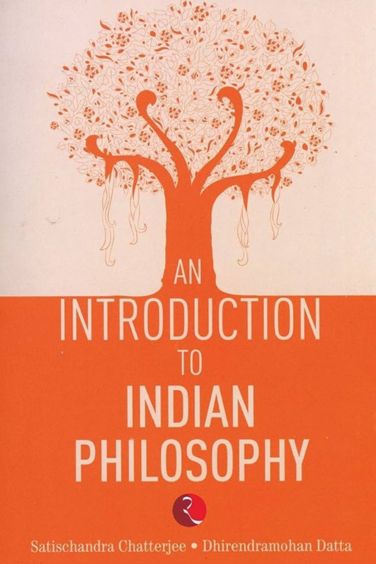
“The self is not the individual body or mind, but rather that aspect deep inside each individual person that knows the truth.” -Swami Vishnudevananda

